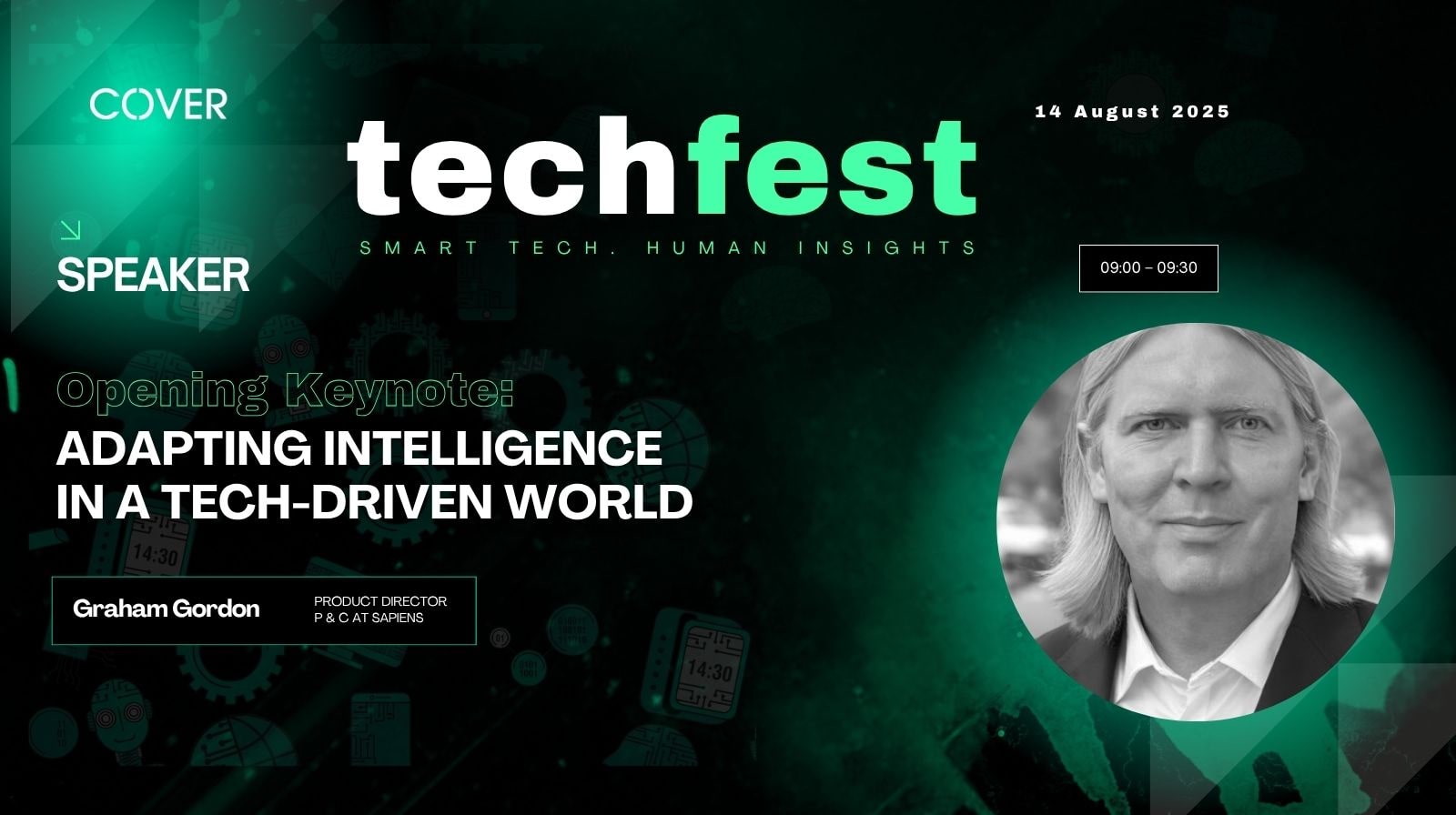
Imagine this: A small fire breaks out at an insured property. Within seconds, an IoT sensor alerts both Emergency Services and the insurer. Drones arrive to scan the damage. Data feeds automatically into underwriting models. A construction agent is dispatched. The customer approves the work with a single click. The entire process updates real-time pricing and P&L reporting.
Sound like science fiction? It's not. According to Graham Gordon, Product and Strategy Director at Sapiens, this scenario could be implemented today. In his opening keynote at TechFest2025, Graham delivered a powerful message: the technology is ready. The question is whether we are.
Graham's vision showcases something profound happening in insurance: the traditional boundaries between claims processing, underwriting, and customer service are dissolving into a single, seamless flow, touchless, data-driven, and immediate.
This isn't theoretical. In automotive claims, AI-powered image recognition is already dramatically reducing turnaround times. The tools exist. The infrastructure is available. What's missing isn't innovation, it's implementation.
Walking through contact centres in Johannesburg, Graham observed something troubling: agents juggling multiple systems, often without access to the intelligence tools that would help them serve customers better.
The challenge isn't a lack of data or AI models. The problem is that insights are locked away in specialised systems, disconnected from the people who need them most.
The breakthrough comes when AI is embedded directly into everyday workflows. Imagine a call centre agent who doesn't just access policy details but receives real-time nudges from the "organisational brain":
This isn't about replacing people, it's about augmenting them. The future is human plus technology: an agent supported by intelligence that makes them as effective as a team of ten.
Graham highlighted a subtle but crucial challenge that many insurers overlook: the accelerating pace of software improvement.
In the past, insurers implemented major upgrades every year or two. Now, each release can bring dozens of new features, multiplying at an exponential rate.
The bottleneck is no longer the technology, it's organisational readiness. Every new feature implies a workflow change, a process adjustment, or a customer-facing shift. The critical question for insurers is whether they're prepared structurally and culturally to absorb change at this speed.
Technology companies are racing ahead. Are your processes, people, and systems keeping pace?
The macro picture makes the urgency even clearer. South Africa's insurance industry has weathered floods, riots, inflation, and load-shedding, all while penetration rates remain stubbornly flat.
Here's the sobering reality: for every rand of premium written, expenses rise almost proportionately. Technology should be breaking that link, yet cost ratios suggest otherwise.
But this challenge reveals an enormous opportunity. If AI and automation can reduce operating costs, insurers can pass those savings to customers. Lower premiums mean broader affordability, higher penetration, and ultimately a society better protected by insurance.
As Graham put it, technology's greatest contribution may be social as much as financial.
Consider the facts:
AI and automation could enable insurers to rethink this entirely, bringing new products, affordability, and protection to millions who currently lack coverage.
To frame this transition, Graham borrowed from the journey of autonomous vehicles. A decade ago, predictions claimed driverless cars would upend the world by 2021. That timeline proved far too ambitious.
But the industry responded intelligently by defining clear levels of automation, from basic driver assistance through to full autonomy. This framework gave everyone a shared language for progress and realistic expectations.
Insurance should adopt a similar model:
Such a framework gives companies, regulators, and customers a way to understand the journey ahead and measure progress meaningfully.
Perhaps the most inspiring part of Graham's keynote was his call to explore the "white space", the untapped areas where AI could transform insurance.
Drawing from his global experience across 200 P&C customers, Graham noted that claims and customer service are leading AI adoption because of volume and cost pressures. But the truly untouched areas, underwriting, fraud detection, portfolio management, are where imagination can run wild.
This is where leaders must step forward. Not to be overwhelmed by possibilities, but to let creativity flow, to identify gaps, and to empower teams to explore them.
The question isn't "Can AI do this?" It's "What becomes possible when we apply intelligence here?"
Listening to Graham's vision, one thing became clear: just as capital constraints once limited business growth, readiness constraints now limit our ability to seize opportunities.
Technology alone isn't enough. The real challenge is preparing ourselves, structurally, strategically, and humanistically, to absorb and deploy it.
This means:
The winners won't be those with the most advanced technology. They'll be those who can adapt their intelligence fastest.
The future Graham described isn't distant, it's already here. AI and automation are ready to transform how insurance works. Drones, IoT sensors, image recognition, predictive models, automated workflows, all available today.
The only question that matters is: Are you ready?
If we can adapt our intelligence, our organisations, our processes, our people—then technology can do what insurance was always meant to do: protect more people, more effectively, at lower cost.
Watch the full TechFest2025 keynote to hear Graham Gordon's complete vision for adapting intelligence in a tech-driven world, including practical frameworks for implementation and insights from global insurance transformation.
The technology is no longer the challenge. Your readiness is the opportunity.